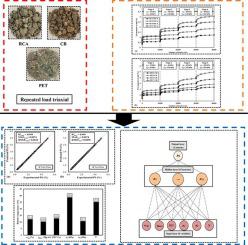Transportation Geotechnics ( IF 4.9 ) Pub Date : 2020-11-30 , DOI: 10.1016/j.trgeo.2020.100481 Behnam Ghorbani , Arul Arulrajah , Guillermo Narsilio , Suksun Horpibulsuk , Myint Win Bo

|
Recycling and reusing construction and demolition (C&D) wastes for civil engineering construction activities has been identified as an energy-saving and sustainable solution. The purpose of this study is to evaluate the deformation behavior of two types of C&D waste materials, namely recycled concrete aggregate (RCA) and crushed brick (CB) when mixed with polyethylene terephthalate (PET) plastic waste. RCA and CB were mixed with 1%, 3%, 5%, and 7% of PET, and the permanent deformation behavior of the blends was evaluated using repeated load triaxial (RLT) test. The shakedown criterion was utilized for identifying the deformation behavior of blends. Most of the PET/RCA and PET/CB blends exhibited Range B (plastic creep) and Range C (incremental collapse) response, respectively, in the investigated stress levels. Shakedown analysis of the test results indicated that up to 3% PET could be mixed with RCA for base/subbase applications, while CB should be mixed with 1% PET, in the subbase layer. Artificial neural network (ANN) method was next used to simulate the permanent strain and shakedown behavior of the blends with consideration of the physical properties and stress states. The ANN model was found to be highly efficient for simulating the permanent strain graph and identifying the shakedown behavior of the blends. A sensitivity analysis was subsequently performed to investigate the impact of input variables on the permanent deformation behavior and the results indicated that number of cycles and confining stress were the most important factors.
中文翻译:

使用实验和神经网络方法对与拆除废弃物作为路面基层/基层材料的PET共混物进行减量分析
用于土木工程建设活动的建筑和拆除(C&D)废物的回收和再利用已被确定为一种节能且可持续的解决方案。这项研究的目的是评估两种类型的拆建废料与再生聚对苯二甲酸乙二醇酯(PET)塑料废料混合后的变形行为,即再生混凝土骨料(RCA)和碎砖(CB)。将RCA和CB与1%,3%,5%和7%的PET混合,并使用重复载荷三轴(RLT)测试评估共混物的永久变形行为。震荡准则用于识别共混物的变形行为。在所研究的应力水平下,大多数PET / RCA和PET / CB共混物分别表现出范围B(塑性蠕变)和范围C(增量塌陷)响应。对测试结果进行的分析表明,在底基层中,可将多达3%的PET与RCA混合,而将CB与1%的PET混合。接下来使用人工神经网络(ANN)方法在考虑物理特性和应力状态的情况下模拟共混物的永久应变和减振行为。发现ANN模型对于模拟永久应变图和识别共混物的击落行为非常有效。随后进行了敏感性分析,以调查输入变量对永久变形行为的影响,结果表明循环次数和约束应力是最重要的因素。而CB应在底层中与1%PET混合。接下来使用人工神经网络(ANN)方法在考虑物理特性和应力状态的情况下模拟共混物的永久应变和减振行为。发现ANN模型对于模拟永久应变图和识别共混物的击落行为非常有效。随后进行了敏感性分析,以调查输入变量对永久变形行为的影响,结果表明循环次数和约束应力是最重要的因素。而CB应在底层中与1%PET混合。接下来使用人工神经网络(ANN)方法在考虑物理特性和应力状态的情况下模拟共混物的永久应变和减振行为。发现ANN模型对于模拟永久应变图和识别共混物的击落行为非常有效。随后进行了敏感性分析,以调查输入变量对永久变形行为的影响,结果表明循环次数和约束应力是最重要的因素。发现ANN模型对于模拟永久应变图和识别共混物的击落行为非常有效。随后进行了敏感性分析,以调查输入变量对永久变形行为的影响,结果表明循环次数和约束应力是最重要的因素。发现ANN模型对于模拟永久应变图和识别共混物的击落行为非常有效。随后进行了敏感性分析,以研究输入变量对永久变形行为的影响,结果表明,循环次数和约束应力是最重要的因素。











































 京公网安备 11010802027423号
京公网安备 11010802027423号